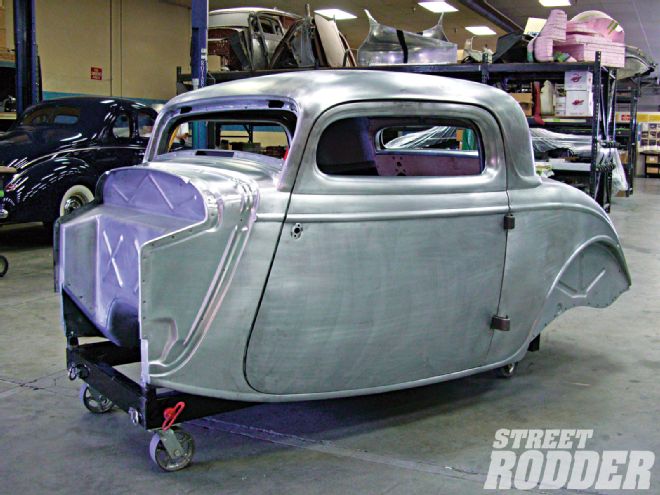
Nothing transforms a car like chopping its top. For good reason; second to sectioning it's the most intense car modification. It's so monumental that it can change a car's entire personality.
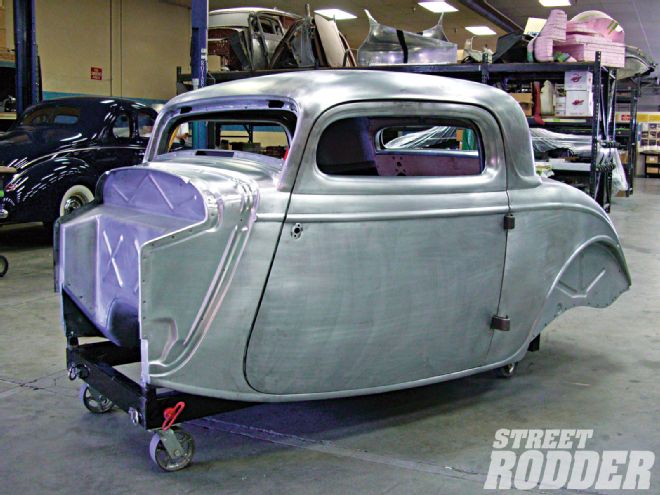 There's hardly a finer-looking old Ford than a Model 40, and there's hardly a better-looking one than one that's been chopped properly. Here's one way to do the job.
There's hardly a finer-looking old Ford than a Model 40, and there's hardly a better-looking one than one that's been chopped properly. Here's one way to do the job.
Of all, the '33 and '34 three-window just about begs for a little off the top. In fact, it's pretty tough to find a famous one that hasn't been chopped: the tops on the Pearson Bros', SO-CAL's, Pete Chapouris' California Kid, Jake's, Cal Tanaka's, Bill Vinther's, Lance Sorchik's, and Randy Bianchi's three-window Model 40s sit just a little bit-or sometimes a lot-lower. Legend has it that Bobby Alloway doesn't even know what a stock-top '33-34 even looks like.
The all-steel, 1934 Ford three-window coupe body that Steve's Auto Restorations (SAR) recently introduced rekindled interest in the Model 40. To make it as appealing as possible, SAR offers the body with a stock-height top, thereby leaving the decision whether to chop, the amount to chop, and the style of chop up to the customer. Just as it will with any other original or reproduction body, SAR will chop the top on its own body-which is exactly what the shop did for the customer who bought this one.
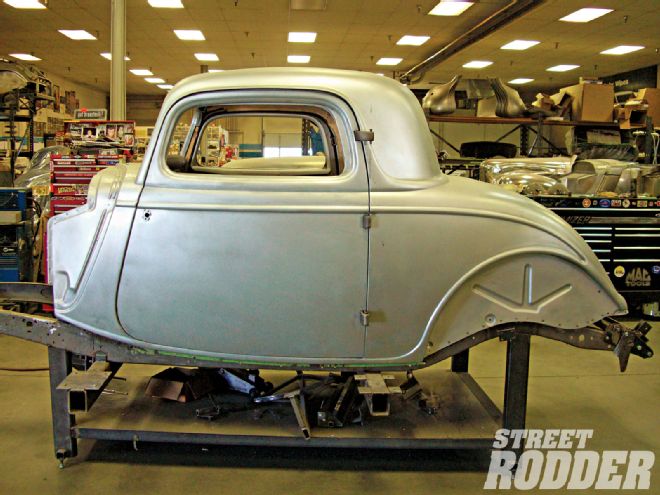 The basis started as one of SAR's new three-window coupe bodies. To give the body the broadest appeal, the company made it in the likeness of a stock '33 and '34 Ford. Dig up your Mar. '09 issue to learn what it took to make this body possible.
The basis started as one of SAR's new three-window coupe bodies. To give the body the broadest appeal, the company made it in the likeness of a stock '33 and '34 Ford. Dig up your Mar. '09 issue to learn what it took to make this body possible.
The SAR body lends itself to chopping even more than the original. A few radius tweaks for consistency withstanding, its top shape is an exact copy of Ford's, however a few of its construction details are unique. Rather than butt-welding the top panels as Ford did, Experi-Metal, the company SAR hired to produce the body, flanged the center panels, overlapped them with the side panels, and spot-welded everything together. Here's why that makes the body so much easier to chop than Ford's:
As explained elsewhere in this article, the Model 40's top is a soft trapezoid. Regardless of chop style, the upper part must expand and the lower part contract if the panels are to meet properly. On a genuine Ford body, that means pie-cutting the base to shrink it, slicing the top to spread it, and filling the gaps that result from spreading the panels. It adds considerable work to the job, which translates to considerable time and, if a pro does it, money.
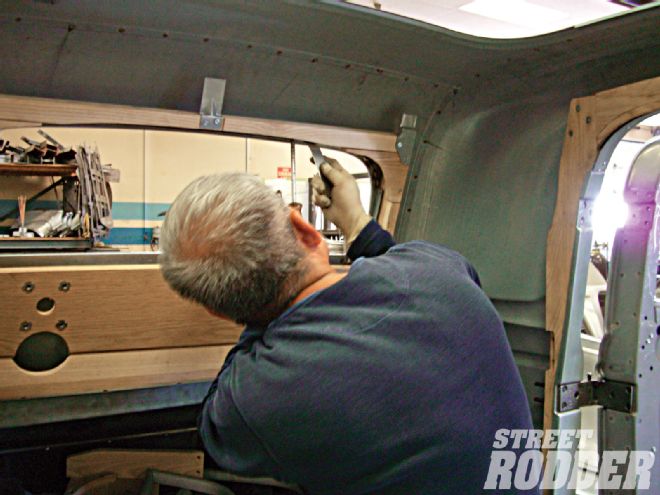 They then removed the wooden rear-window structure. Unlike the hinges this will go back into the car, albeit in shorter form.
They then removed the wooden rear-window structure. Unlike the hinges this will go back into the car, albeit in shorter form.
That's where the overlapping panel construction helps. Tell SAR to forego finishing the seam and the panels come apart by drilling the spot welds. Then the top components can be tapered and spread at will. The fabricators at SAR say that unless the chop is extreme there's usually sufficient overlapped material to reduce if not completely eliminate the need to create fillers.
In this case, Duc Pham and Joe Cusic clipped the top 3-1/4 inches at the rear and 3-1/2 inches at the front of a customer's body. It makes the car look aggressive without sacrificing its vintage personality or tractability (mail-slot windows in heavily chopped tops can make cars ungainly to use, if not ungainly looking). It also just happens to be a cut that doesn't require extensive clean up. They also lengthened the top instead of slanting the posts as explained elsewhere in this story.
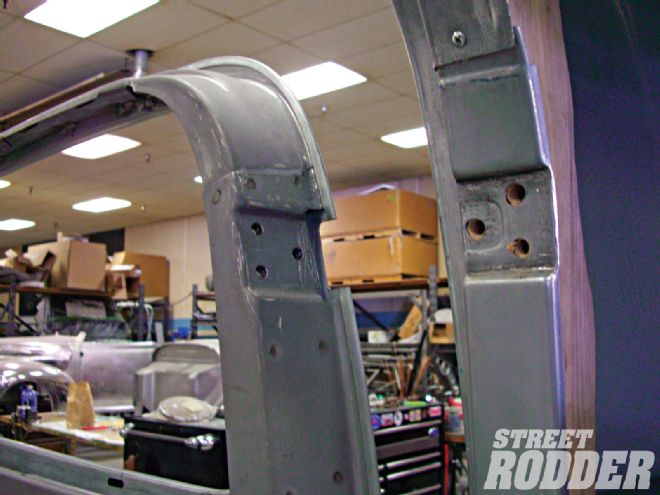 Seeing how the hinges interfere with any chop, Duc Pham and Joe Cusic removed them. The reduced door height makes them unnecessary, a good thing since their reinstallation would cause a fair deal of effort.
Seeing how the hinges interfere with any chop, Duc Pham and Joe Cusic removed them. The reduced door height makes them unnecessary, a good thing since their reinstallation would cause a fair deal of effort.
And the results speak for themselves: the Model 40 body is something else, and the cut puts it in another league altogether.
To Stretch or Slant
There are as many ways to chop a top as there are cars, but most would-be top choppers reach a fork in the road: stretch or slant?
The reason is top profile. By the early '30s, most car manufacturers adopted a more trapezoidal top style. While it made the stock tops look sleeker, chopping them creates a ponderous situation: the chopped top ends up too short to fit the body. Aligning the top by one set of pillars makes the other set fall short by an amount determined by the angle of the pillars and the extent of the chop.
In very broad terms there are two solutions: stretching the top or slanting the posts. Stretching the top involves splitting the top skin width-wise, aligning the pillars with each other, and bridging the gap created by lengthening the top skin. Slanting the pillars requires cutting a wedge out of the lower A-pillars to move the windshield posts back and slitting the upper windshield posts to move them forward until the cut edges meet.
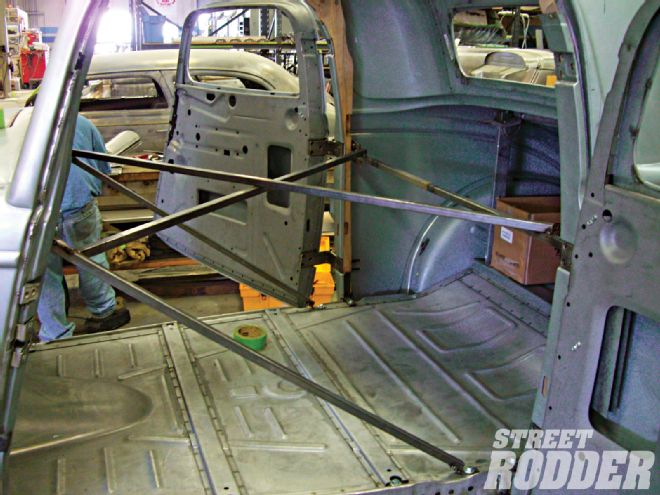 A closed car's top constitutes a great deal of the body's structure and removing it can cause the body to shift uncontrollably. Before cutting a single panel, the duo fabricated a framework to preserve the body's shape, that way the body will fit and the doors will operate properly.
A closed car's top constitutes a great deal of the body's structure and removing it can cause the body to shift uncontrollably. Before cutting a single panel, the duo fabricated a framework to preserve the body's shape, that way the body will fit and the doors will operate properly.
At face value leaning the posts seems best: it lends a car a really aggressive look. Racers like Bob and Dick Pearson did just that on their famed '33 coupe to make their car more aerodynamic and to skirt an SCTA windshield-height rule. Its shape naturally inspired dozens of copies.
But leaning only the posts has some sobering consequences. Were the windshield flat at the bottom as it was in the Model T up to '25, there would be no problems. The frame shape would match the opening no matter how you leaned it. Not so with a '26-and-later car: the frame and openings arch at the middle. So leaning only the windshield frame in a Model 40 creates another ponderous problem: the lower corners won't seat properly. And a leaky windshield on a cold night, or even worse, a cold, rainy night, is pretty far from cool.
The remedy is intense: it involves leaning the whole windshield opening, a task that requires cutting the windshield frame from the body, leaning it back, reshaping the cowl to match, and filling the resulting gaps. Some say just the cowl work can be more involved than the chop itself.
Duc Pham and Joe Cusic chose to stretch the top for several reasons, not the least of which was the customer's preference. It's unfair to say that stretching a top is exclusively a financial decision: stretching the top retains the A-pillar angle, which preserves an old car's vintage character. After all, not every car looks best when made to look super swoopy.